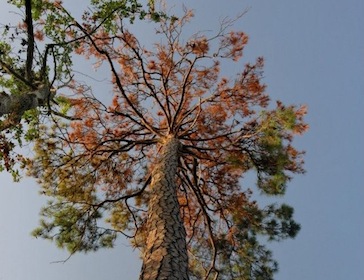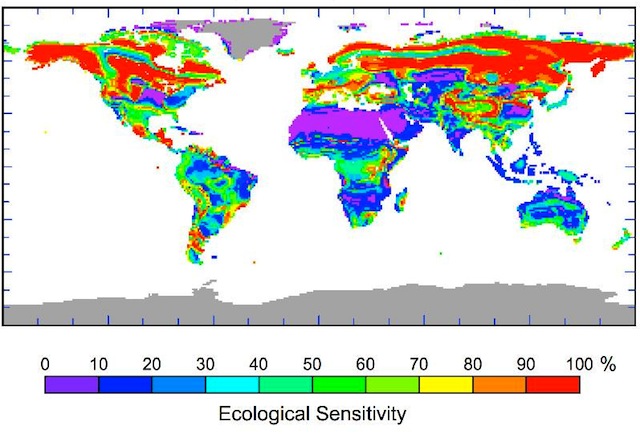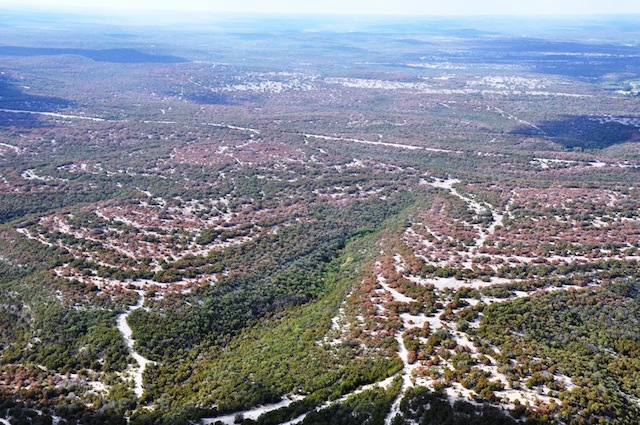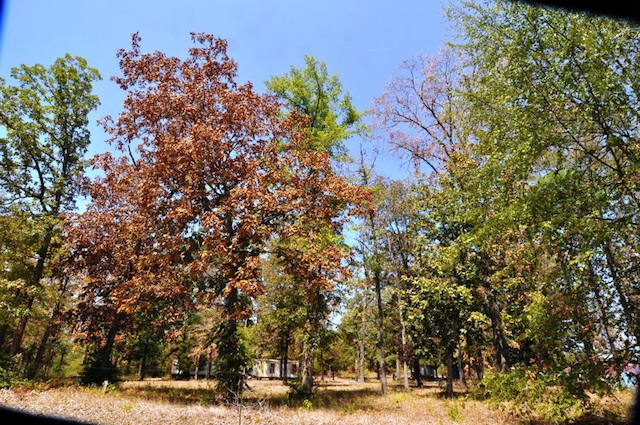 The continuing Texas drought has taken an enormous and growing toll on trees, killing as many as half a billion – 10 percent of the state’s 4.9 billion trees – this year alone, the Texas Forest Service estimates.
The continuing Texas drought has taken an enormous and growing toll on trees, killing as many as half a billion – 10 percent of the state’s 4.9 billion trees – this year alone, the Texas Forest Service estimates.
That calculation did not include trees claimed by this year’s deadly and extensive wildfires, even if they were drought-related, Burl Carraway, who heads the agency’s Sustainable Forestry Department, told Texas Climate News.
(Previously, the Forest Service estimated that about 1.5 million trees were lost on 34,000 charred acres in the Bastrop County fire, most destructive in Texas history. In another damage assessment, the agency said more than 2,000 fires in East Texas had charred more than 200,000 acres. Texas has about 63 million acres of forestlands.)
The estimate that up to half a billion trees have been lost to drought in 2011 was issued Monday by the Forest Service. It was based on statistics tabulated by agency foresters after they canvassed local forestry professionals in their regions, developed estimated percentages of drought-killed trees, and applied them to regional tree inventories.
The resulting estimate was that 100 million to 500 million trees with a diameter of at least five inches had perished because of the drought – two to 10 percent of the nearly five billion trees of that size in the state.
In announcing the estimate, Carraway said:
In 2011, Texas experienced an exceptional drought, prolonged high winds and record-setting temperatures. Together, those conditions took a severe toll on trees across the state. Large numbers of trees in both urban communities and rural forests have died or are struggling to survive. The impacts are numerous and widespread.
The agency found that trees in three areas appeared to be hurt the most by the drought:
- An area in West Texas including Sutton, Crockett, western Kimble and eastern Pecos counties, with extensive death of Ashe junipers.
- An area in Southeast Texas including Harris, Montgomery, Grimes, Madison and Leon counties, where many loblolly pines succumbed.
- An area southeast of Austin, including western Bastrop and eastern Caldwell counties as well as neighboring areas, which had widespread mortality among cedars and post oaks.
Also, the agency said, “localized pockets of heavy mortality were reported for many other areas.
The Forest Service plans to use aerial imagery in a more detailed analysis next spring, when trees that entered early dormancy because of the drought may start to recover. In addition, the agency said, “a more scientific, long-term study” of tree losses will be carried out through its Forest Inventory and Analysis program’s census of the state’s trees. Carraway said Forest Service officials “fully expect mortality percentages to increase if the drought continues.”
Texas state climatologist John Nielsen-Gammon has said that a second year of drought in 2012 is “likely,” perhaps with more dry conditions following that.
+++++
Nielsen-Gammon has estimated that about a tenth of the excess heat this past summer was attributable to manmade climate change. He and other climate experts have said hotter, drier conditions are expected to increase in Texas in decades ahead as concentrations of human-created greenhouse gases accumulate in the atmosphere.
What the warming average temperature of the planet could mean for forests and other ecosystems was the focus of research findings announced last week by NASA.
The study, carried out by researchers from NASA’s Jet Propulsion Laboratory and the California Institute of Technology, used a computer model that projected massive changes in plant communities across nearly half of the earth’s land surface, with “the conversion of nearly 40 percent of land-based ecosystems from one major ecological community type – such as forest, grassland or tundra – toward another.”

Changes in plant species: NASA/Caltech study's predicted percentages of landscapes where human-caused climate change is expected to cause changes in plant species by 2100
The NASA announcement added:
The model projections paint a portrait of increasing ecological change and stress in Earth’s biosphere, with many plant and animal species facing increasing competition for survival, as well as significant species turnover, as some species invade areas occupied by other species. Most of Earth’s land that is not covered by ice or desert is projected to undergo at least a 30 percent change in plant cover – changes that will require humans and animals to adapt and often relocate.
In addition to altering plant communities, the study predicts climate change will disrupt the ecological balance between interdependent and often endangered plant and animal species, reduce biodiversity and adversely affect Earth’s water, energy, carbon and other element cycles.
“For more than 25 years, scientists have warned of the dangers of human-induced climate change,” said Jon Bergengren, a scientist who led the study while a postdoctoral scholar at Caltech. “Our study introduces a new view of climate change, exploring the ecological implications of a few degrees of global warming. While warnings of melting glaciers, rising sea levels and other environmental changes are illustrative and important, ultimately, it’s the ecological consequences that matter most.”
When faced with climate change, plant species often must “migrate” over multiple generations, as they can only survive, compete and reproduce within the range of climates to which they are evolutionarily and physiologically adapted. While Earth’s plants and animals have evolved to migrate in response to seasonal environmental changes and to even larger transitions, such as the end of the last ice age, they often are not equipped to keep up with the rapidity of modern climate changes that are currently taking place. Human activities, such as agriculture and urbanization, are increasingly destroying Earth’s natural habitats, and frequently block plants and animals from successfully migrating.
– Bill Dawson
Image credits: Photos – Texas Forest Service; Map – NASA


